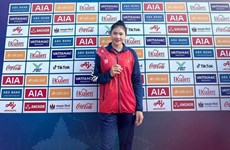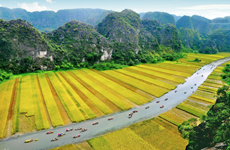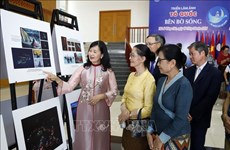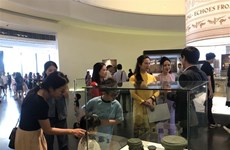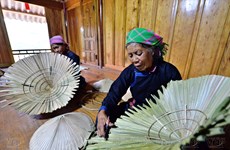Lacquer and ottchil arts need recognition
The Republic of Korea’s artist Jin Su-jang was intrigued by the Vietnamese son mai paintings she saw when she came to Hanoi to showcase her own Korean ottchil artworks at the Vietnam Fine Arts Museum.
 A son mai painting, Mua Thu (Autumn), 90cm by 120cm by veteran artist Ly Truc Son in 2015.
A son mai painting, Mua Thu (Autumn), 90cm by 120cm by veteran artist Ly Truc Son in 2015. Hanoi, (VNA) – The Republic of Korea’s artist Jin Su-jang was intrigued by the Vietnamese son mai (lacquer) paintings she saw when she came to Hanoi to showcase her own Korean ottchil artworks at the Vietnam Fine Arts Museum.
While her paintings were done in the Korean ottchil style, she gained a new appreciation for the Vietnamese art form while participating in the first ever exhibition in Vietnam between local and the Republic of Korea’s artists to showcase nearly 40 paintings.
"When I see son mai paintings on the internet, I cannot feel the depth of the painting," Jin said. "It is interesting to recognise that there is a connection among colours in son mai paintings."
Jin said there are noticeable differences between the two styles.
"It is a distinction because colours are exact in Korean ottchil paintings," Jin said. "White colour will definitely be white in ottchil paintings, but I can see colour intensity in Vietnamese son mai paintings."
Jin is one of 12 Korean artists who have contemporary ottchil paintings on display at the exhibition entitled "Vietnamese Son Mai-Korean Ottchil", which runs until December 12 at 66 Nguyen Thai Hoc street.
Vietnamese son mai is a traditional handicraft first used during Vietnam's feudal era. Son mai painting has evolved over time, especially during the 1930s when artists and students at L'Ecole des Beaux Art d'Indochine (Indochina Fine Arts School) resurrected the medium, fusing it with French techniques and positioning it as a fine art.
The medium gets its name from sap extracted from the son tree that inhabits the mountains of the northern province of Phu Tho.
Meanwhile, Korean ottchil is the art of mixing sap from the ott-namu tree with other materials such as eggshell and mother of pearl.
The Korean artists are from a resident artist programme that has been funded by the Ottchil Tongyeong Museum in Gyeongsangnam-do.
Jin has two paintings at the exhibition entitled Secret of Natural Forest and Secret of Green Forest.
The paintings are her latest ottchil works, which were made over the course of three months.
"Jin and other artists are my students," said Ottchil Tongyeong Museum's director Kim Sung-so. "They were selected from many students due to their individual strong points at different processes of ottchil such as inlaying and plywood board making."
Kim also introduced his ottchil painting at the exhibition. Entitled Balance and Harmony, the piece consists of many small squares with mother-of-pearl inlay.
Born in 1935, Kim taught for over 30 years in the Republic of Korea and for the Office National de l'Artisanat Tunisien in Tunisia, in 1973-75.
He is currently the chair and professor of Ottchil Arts at Dongbang Graduate University in Seoul. Kim is a pioneer in reviving and modernising contemporary Korean ottchil art.
He started to learn about son mai in 2007 when he attended an exhibition held in China's Hubei province, and he has been researching the art form ever since.
"I studied son mai and learned that there was an exhibition introducing son mai in 1925 at the Indochina Fine Arts School," said Kim.
"It's a surprise to me, a Korean ottchil researcher for 65 years. I used to think that there was no country except Korea that has a traditional art using resin of a tree to paint."
Kim made great efforts with support from the Korean Cultural Centre's director Park Nark-jong in Hanoi to hold the exhibition in Vietnam. It was also funded by the Republic of Korea’s government in an effort to breathe life into the folk art.
"In Korea, the traditional ottchil art has been fading away," he said. "It's difficult to find ottchil artists. Many Korean youngsters do not know about ottchil."
"Our work is not only to create new artworks, but also revive the traditional art," he said. "It is interesting to introduce the two traditional arts of Vietnam and Korea at the exhibition."
Kim also urged Vietnamese artists to discuss son mai in international dialogues.
"Son mai is translated as 'lacquer' in English. But it is not exact because lacquer means painting with many layers. It cannot express the full meaning of son mai," he said.
The exhibition also introduces 12 son mai paintings by Vietnamese artists, including established artist Ly Truc Son and emerging artist Dang Hien.
"The exhibition shows differences between Vietnamese and Korean traditional art," said art critic Doan. "Korean artists are prominent with inlay mother-of-pearl, while Vietnamese artists are more diverse."
Doan said Korean ottchil paintings utilise mother-of-pearl, while Vietnamese son mai paintings use materials such as eggshell, gold leaf and silver leaf to create colours.
"Ottchil artists work on the surface of a plywood board, while son mai artists have to work with various steps to create a work," Doan said after he participated in a workshop held at the Korean centre.
Doan said son mai paintings are often multi-layered, which gives the paintings their colour.
"The artists rub layers to create different hues of colour that they want," he said. "This makes the depth of the paintings."
The workshop is one of a series of activities held at the Korean Centre with participation from the artists. They also visit Ly Truc Son's studio in Gia Lam.
"I'm excited to visit artist Son's studio," Jin said. "It will be a rare chance for us to see how Vietnamese son mai paintings are made."-VNA









